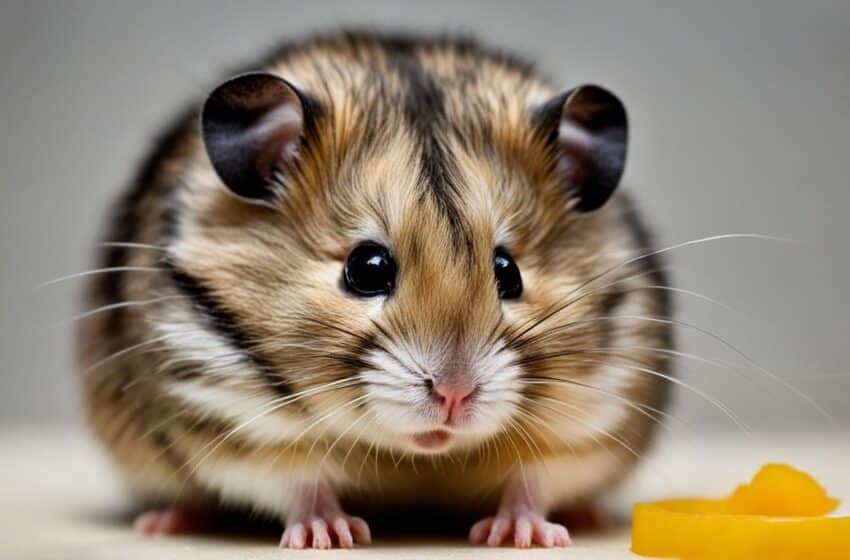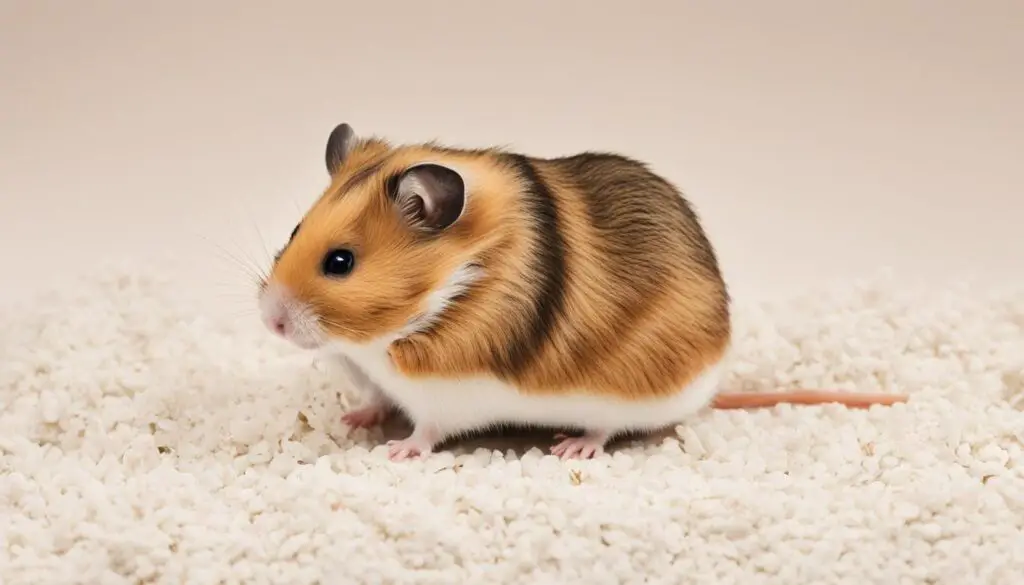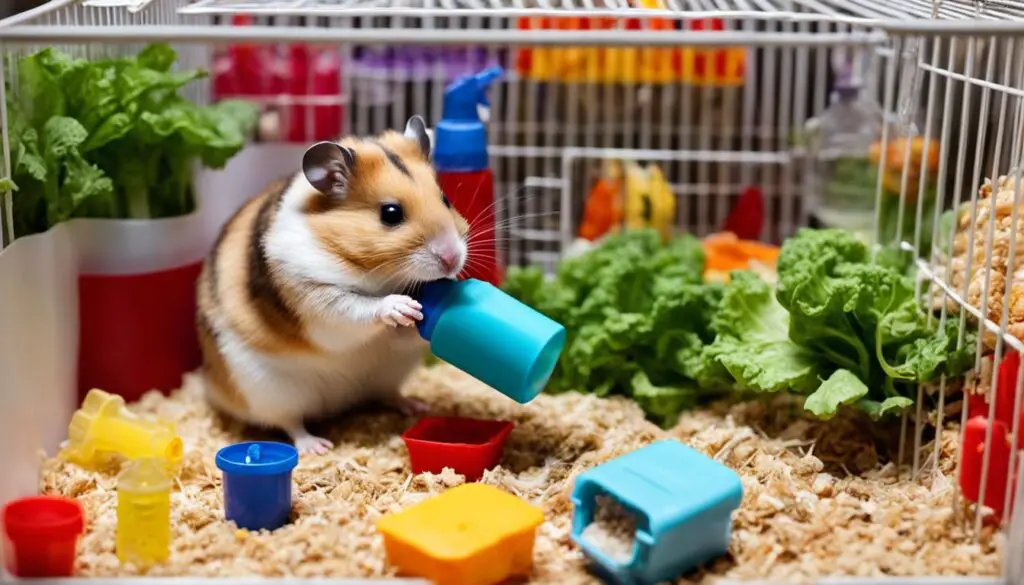How to Spot Respiratory Problems in Hamsters

As a pet owner, it’s important for me to be able to identify the signs of respiratory problems in hamsters. These small pets are susceptible to respiratory issues, and early detection and proper care are crucial for maintaining their health. In this article, I will discuss how to spot respiratory problems in hamsters and provide expert tips on ensuring their well-being.
Key Takeaways:
- Respiratory problems in hamsters can be identified through signs such as sneezing, wheezing, labored breathing, nasal discharge, and lethargy.
- Poor ventilation, exposure to dust or irritants, overcrowded living conditions, and stress are common causes and risk factors of respiratory problems in hamsters.
- Preventing respiratory problems in hamsters involves providing a clean and well-ventilated cage, removing potential irritants, maintaining proper humidity levels, and minimizing stress.
- If you suspect any respiratory problems in your hamster, seek veterinary care promptly for appropriate diagnosis and treatment.
- By being vigilant and proactive, you can help your hamster avoid respiratory issues and keep them happy and healthy.
Common Signs of Respiratory Problems in Hamsters
Respiratory problems in hamsters can manifest in various ways. It’s important to be vigilant and recognize the common signs of respiratory issues to ensure prompt care for your furry friend.
Sneezing: Excessive sneezing, especially accompanied by other symptoms, can indicate a respiratory problem in hamsters.
Wheezing: If you notice your hamster making unusual wheezing sounds or struggling to breathe, it may be a sign of respiratory distress.
Labored Breathing: Difficulty breathing, characterized by rapid or shallow breaths, can point to a respiratory issue requiring medical attention.
Nasal Discharge: Watch for any abnormal discharge from your hamster’s nose, such as mucus or blood, as it may indicate an underlying respiratory problem.
Lethargy: A lethargic hamster that lacks energy and enthusiasm may be experiencing respiratory difficulties.
If you observe any of these symptoms in your hamster, it’s crucial to take immediate action. Early detection and intervention can help prevent further complications and promote a speedy recovery.
Expert Tip:
“If your hamster is exhibiting signs of respiratory problems, isolate it from other pets and do not expose it to smoke or other irritants. Schedule a veterinary appointment to get a proper diagnosis and appropriate treatment options for your furry companion.” – Dr. Emily Roberts, Veterinarian
Creating an optimal environment for your hamster is crucial for their respiratory health. In the next section, we will explore the causes and risk factors that can contribute to respiratory problems in these small pets.
Causes and Risk Factors of Respiratory Problems in Hamsters
Respiratory problems in hamsters can arise from various causes and risk factors. Understanding these factors is essential for ensuring the well-being of your furry friend. Some of the common causes and risk factors that can compromise a hamster’s respiratory health include:
- Poor ventilation: Inadequate airflow and poor ventilation in the hamster’s living environment can lead to respiratory issues.
- Exposure to dust or irritants: Dust, allergens, smoke, or strong odors can irritate the hamster’s respiratory system and trigger problems.
- Overcrowded living conditions: Hamsters kept in cramped or overcrowded cages may be more at risk for respiratory problems due to the limited space and increased exposure to pathogens.
- Stress: Stress weakens the hamster’s immune system, making them more susceptible to respiratory infections and complications.
To minimize the risk of respiratory problems in your hamster, it’s crucial to create a clean and stress-free environment. Ensure proper ventilation in the cage, maintain cleanliness by regularly removing soiled bedding, and avoid exposing your hamster to dust, smoke, or other respiratory irritants.
Providing your pet with ample space, proper hygiene, and a calm living environment will significantly reduce the likelihood of respiratory issues.

Prevention and Care for Respiratory Problems in Hamsters
As a responsible hamster owner, it’s essential to take proactive measures to prevent respiratory problems in your furry friend. By providing a clean and well-ventilated cage, you can create a healthy environment that promotes respiratory wellness. Regular cleaning and removing potential irritants such as cedar or pine bedding are crucial steps in maintaining your hamster’s respiratory health.

In addition to maintaining cleanliness, controlling humidity levels is equally important. Hamsters thrive in an environment with moderate humidity, so ensure that the humidity in their cage is within the recommended range for their species. Excessive humidity can lead to respiratory issues, while low humidity can cause dryness and discomfort.
Reducing stress is another key aspect of respiratory care for hamsters. Like humans, stress can weaken their immune system, making them more susceptible to respiratory problems. Provide your hamster with a quiet and calm environment, away from loud noises or sudden disturbances. Incorporate enrichment activities and toys to provide mental stimulation, reducing stress levels and promoting overall well-being.
Preventive Measures for Respiratory Health
To summarize, here are some preventive measures you can take to ensure the respiratory health of your hamster:
- Regularly clean the cage to remove waste and potential irritants.
- Avoid using bedding made from cedar or pine, as they can be harmful to their respiratory system.
- Maintain proper humidity levels in the cage.
- Minimize stress by creating a calm and quiet environment.
Despite your best efforts, respiratory problems can still occur in hamsters. If you notice any symptoms of respiratory distress, such as labored breathing or excessive sneezing, it is crucial to seek professional veterinary care promptly. Early detection and proper treatment are vital for the well-being of your hamster.
By taking preventive measures and providing attentive care, you can significantly reduce the risk of respiratory problems in your beloved hamster.
Conclusion
Spotting respiratory problems in hamsters is crucial for ensuring their well-being. These small pets are prone to respiratory issues, and early detection is key to providing timely care. By being aware of the common signs, causes, and risk factors, as well as implementing preventive measures, you can help your hamster avoid respiratory problems.
If you notice any signs of respiratory distress in your hamster, such as sneezing, wheezing, or labored breathing, it is important to seek veterinary care promptly. Respiratory problems can rapidly worsen if left untreated, posing a serious risk to your pet’s health.
In order to prevent respiratory problems in hamsters, it is essential to create a clean and well-ventilated environment for them. Regular cleaning of their cage, removing potential irritants like cedar or pine bedding, and maintaining optimal humidity levels are all important steps to minimize the risk of respiratory issues.
By providing proper attention and care to your hamster’s respiratory health, you can keep them happy and healthy. Remember, prevention and early intervention are key to ensuring a long and comfortable life for your furry friend.
FAQ
What are the signs of respiratory problems in hamsters?
The signs of respiratory problems in hamsters include sneezing, wheezing, labored breathing, nasal discharge, and lethargy.
What can cause respiratory problems in hamsters?
Respiratory problems in hamsters can be caused by poor ventilation, exposure to dust or irritants, overcrowded living conditions, and stress.
How can I prevent respiratory problems in hamsters?
To prevent respiratory problems in hamsters, provide a clean and well-ventilated cage, remove potential irritants such as cedar or pine bedding, maintain proper humidity levels, and minimize stress.
What should I do if my hamster has a respiratory problem?
If your hamster has a respiratory problem, it is important to consult a veterinarian for appropriate care and treatment options.



